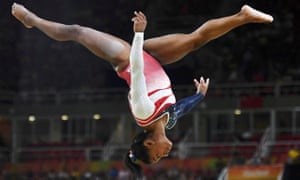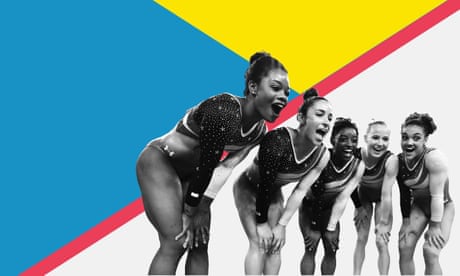Young Simone Biles redefines perfection in sports
The young American’s artistry and athleticism take gymnastics once more into a philosophical search for the ultimate routine

To understand the predominance of the United States gymnast Simone Biles, take a look at a picture of her steering the American team to a gold medal – upside down and mid-air in mid-routine. Her legs are at 180 degrees, her body straight, arms in symmetry, and eyes fixed on a single point to ensure her landing. It is pure focus with no shred of strain – a moment seized from the jaws of gravity.
I watch this with the prickle of envy and excitement of a former gymnast (though hardly one who was a threat to Soviet-bloc dominance in my day). When I was bashing away at free cartwheels and back-flips, gymnastics was undergoing radical change from the rise of the elfin Olga Korbut at the Munich games in 1972 and the classicism of Ludmilla Tourischeva. The Nadia Comăneci perfect 10 is an ideal that still haunts the sport 40 years after the Montreal Olympics.

How the USA women’s gymnastics team swept to Olympic gold
But it was also an era of forgotten leaps forward –Svetlana Grozdova’s supple forward walkover performed across the four-inch beam, rather than along it. Double somersaults being performed by the top women and triples for the men. Nikolai Andrianov, the perfect army-trained Soviet medal machine – winning 15 Olympic medals, a tally only occluded byMichael Phelps.
Catherine-wheel kinetics and athleticism came to dominate a sport that had once been a series of tumbles and balances with a bit of dance in between. Just as the “Sputnik shock” in the space race had earlier spurred the US’s technological advancement, the other sports superpower was galvanised to produce a stream of winners. Paradoxically, the US star-makers hailed from the heart of the old eastern bloc: Béla and Márta Károlyi, Comăneci’s coaches from Romania, have trained a string of American gold medallists since the Atlanta breakthrough of 1996.Mary Lou Retton, Kerri Strug, Gabby Douglas – all were tough get-outta-my-way girls with fire and drive. Biles is the natural progression to an outlier.
Some things have been gained and some lost along the way. The focus on hair and glittery makeup for women, such as Biles’s Swarovski crystal-strewn leotard. Routines now are punishing, super-fast accumulations of elements to pounding music.
The Biles back story is an uplifting tale of a fostered child brought up in modest circumstances by a grandfather who indulged her drive to succeed. In terms of her impact on the sport, she represents something else: a return of the quest for perfection.
This is the aspect that lifts gymnastics from the sweaty floormats into the philosophical – the search for the perfect routine, balanced between artistry and athletic achievement. In athletics, the four-minute mile and the 10-second 100 metres sprint were once the equivalent ultimate goals. In clock-timed sports, the difference of a split second makes scoring easier. Ice-skating allows for individual differences between judges (older readers will remember the East German judge jokes for giving low scores to any other nations).Gymnastics aggregates scores between the judges on two separate panels to come to final result, often with a fair bit of arguing.
But once the perfect 10 had been granted to Comăneci in 1976, others followed, so what could supersede it? Attempts to resolve this drew the sport’s authorities into a madly overcomplicated scoring system of minuscule decimal differences.

The extraordinary Simone Biles, the best athlete in America today
“I’m kinda hoping one falls over so I can work out who’s lost,” muttered the man behind me at the London Olympics. One helpful commentary on the “code of points” seeks to sort out the ratings for difficulty thus: “There is now an ‘H’ value for a skill being worth eight tenths. The double double tuck is an “H” skill. There is also 0.3CV (difficulty rating for a linking move).” For example a C + E (Double salto) indirect will give a gymnast 0.3CV
Biles has cut through this arcane muddle by being so much better than the pack that she is regarded in the same way that athletes regard Usain Bolt or tennis player Roger Federer at his peak. Other participants joke that the only competition is for second place, so obviously superior is Biles. Her 15.933 on the vault in effect makes a 16 score the new 10. Where does this new leap forward leave the old perfection quest? It always was a glorious impossibility – human movement is never without flaws, even at its peak.
Pedants will do the same for Biles, or search for the missing .067 points. But the complexity of her routines and the sheer reliability of her results banishes quibbles. As in the days of Comăneci, you will hear people say that there are only so many twisting turns and revolutions that a body is capable of in space and time, however concentrated the training. (Biles has a gym routine that would have exhausted Mike Tyson, leaving legs so sore they are treated with a suit of compressed air.)
I’m not convinced of these limits, for the same reason that human progress is so often underestimated. That is why the perfect 10 is now de facto the perfect 16, and before I have done my last wobbly handstand in the garden, it will be something else and something more. Such is the enchanted essence of gymnastics. It gets closer and closer to something perfect – just before perfect moves on again.
Comments
Post a Comment